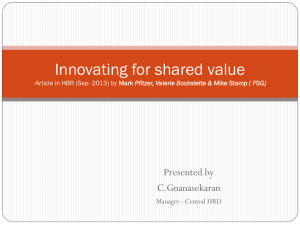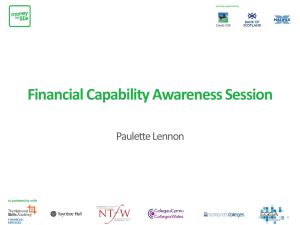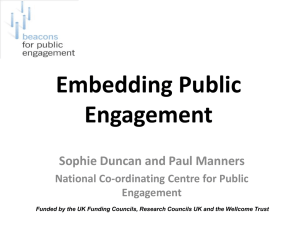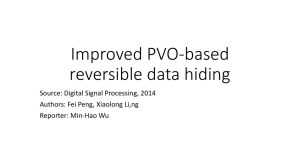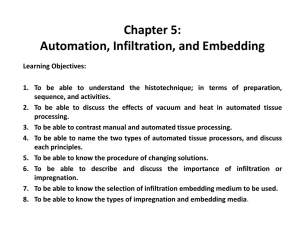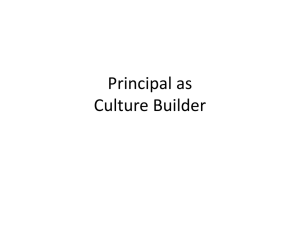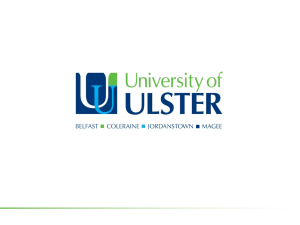Secure Steganographic Methods for Palette Images
advertisement
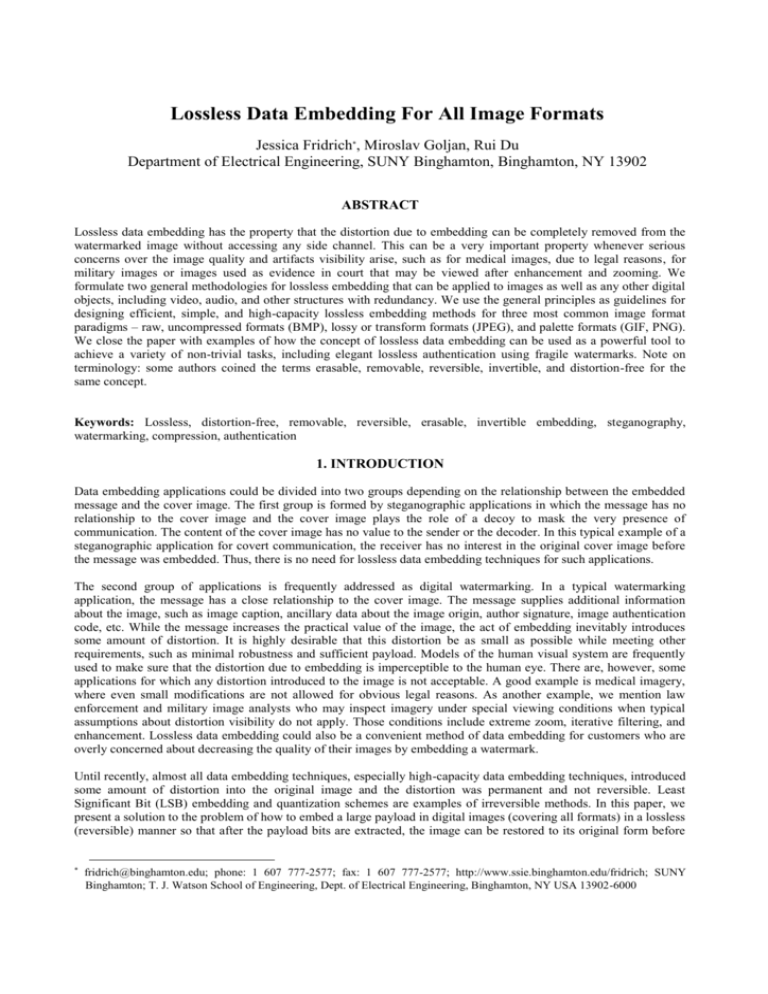
Lossless Data Embedding For All Image Formats
Jessica Fridrich*, Miroslav Goljan, Rui Du
Department of Electrical Engineering, SUNY Binghamton, Binghamton, NY 13902
ABSTRACT
Lossless data embedding has the property that the distortion due to embedding can be completely removed from the
watermarked image without accessing any side channel. This can be a very important property whenever serious
concerns over the image quality and artifacts visibility arise, such as for medical images, due to legal reasons, for
military images or images used as evidence in court that may be viewed after enhancement and zooming. We
formulate two general methodologies for lossless embedding that can be applied to images as well as any other digital
objects, including video, audio, and other structures with redundancy. We use the general principles as guidelines for
designing efficient, simple, and high-capacity lossless embedding methods for three most common image format
paradigms – raw, uncompressed formats (BMP), lossy or transform formats (JPEG), and palette formats (GIF, PNG).
We close the paper with examples of how the concept of lossless data embedding can be used as a powerful tool to
achieve a variety of non-trivial tasks, including elegant lossless authentication using fragile watermarks. Note on
terminology: some authors coined the terms erasable, removable, reversible, invertible, and distortion-free for the
same concept.
Keywords: Lossless, distortion-free, removable, reversible, erasable, invertible embedding, steganography,
watermarking, compression, authentication
1. INTRODUCTION
Data embedding applications could be divided into two groups depending on the relationship between the embedded
message and the cover image. The first group is formed by steganographic applications in which the message has no
relationship to the cover image and the cover image plays the role of a decoy to mask the very presence of
communication. The content of the cover image has no value to the sender or the decoder. In this typical example of a
steganographic application for covert communication, the receiver has no interest in the original cover image before
the message was embedded. Thus, there is no need for lossless data embedding techniques for such applications.
The second group of applications is frequently addressed as digital watermarking. In a typical watermarking
application, the message has a close relationship to the cover image. The message supplies additional information
about the image, such as image caption, ancillary data about the image origin, author signature, image authentication
code, etc. While the message increases the practical value of the image, the act of embedding inevitably introduces
some amount of distortion. It is highly desirable that this distortion be as small as possible while meeting other
requirements, such as minimal robustness and sufficient payload. Models of the human visual system are frequently
used to make sure that the distortion due to embedding is imperceptible to the human eye. There are, however, some
applications for which any distortion introduced to the image is not acceptable. A good example is medical imagery,
where even small modifications are not allowed for obvious legal reasons. As another example, we mention law
enforcement and military image analysts who may inspect imagery under special viewing conditions when typical
assumptions about distortion visibility do not apply. Those conditions include extreme zoom, iterative filtering, and
enhancement. Lossless data embedding could also be a convenient method of data embedding for customers who are
overly concerned about decreasing the quality of their images by embedding a watermark.
Until recently, almost all data embedding techniques, especially high-capacity data embedding techniques, introduced
some amount of distortion into the original image and the distortion was permanent and not reversible. Least
Significant Bit (LSB) embedding and quantization schemes are examples of irreversible methods. In this paper, we
present a solution to the problem of how to embed a large payload in digital images (covering all formats) in a lossless
(reversible) manner so that after the payload bits are extracted, the image can be restored to its original form before
*
fridrich@binghamton.edu; phone: 1 607 777-2577; fax: 1 607 777-2577; http://www.ssie.binghamton.edu/fridrich; SUNY
Binghamton; T. J. Watson School of Engineering, Dept. of Electrical Engineering, Binghamton, NY USA 13902-6000
the embedding started. Even though the distortion is completely invertible, we pay close attention to minimizing the
amount of distortion after embedding.
The concept of distortion-free data embedding appeared for the first time in an authentication method developed by
Honsinger6. The data is embedded using a spatial additive non-adaptive robust watermark7 using addition modulo
256. The modulo addition may introduce some distortion into the watermarked image Iw when pixels with grayscales
close to zero are flipped to values close to 255 and vice versa. Thus this lossless data embedding scheme will work as
long as the watermarking scheme is robust with respect to the flipped pixels, which generally form a correlated saltand-pepper noise. If the number of flipped pixels is too large, such as for astronomical images, it may not be possible
to extract the payload correctly from the watermarked image. Another problem with this scheme is that the flipped
pixels are very visible and the distortion in the watermarked image, albeit erasable, may be objectionable in many
applications. The problem with the visibility of the artifacts can be partially alleviated by using different modulo
additions on disjoint intervals1. More detailed analysis and further generalization of this technique can be found in our
previous work1.
Macq8 described a modification to the patchwork algorithm to achieve lossless watermark embedding. He also uses
addition modulo 256 and essentially embeds a one-bit watermark. Both Honsinger’s method6 and the method by
Macq8 cannot be used for embedding large payloads. Even though the distortion they introduce is erasable, the visible
artifacts they may introduce may not be acceptable in many applications. Finally, the methods are not easily
extendable to other image formats, such as the JPEG.
In the next section, we describe two general mechanisms for building lossless embedding techniques for any digital
object, including digital images, video, and audio files. Then in Section 3, we briefly describe a lossless method that
we previously proposed and analyzed for raw, uncompressed formats, such as the BMP format. In Section 4, we
continue with lossless data embedding methods for the JPEG format. Several new methods for the palette formats
(GIF, PNG) are covered in Section 5. Finally, in Section 6, we briefly discus some important applications of lossless
data embedding, including invertible fragile image authentication and accurate steganalysis of LSB embedding. The
paper is concluded in Section 7.
2. GENERAL METHODOLOGY FOR LOSSLESS DATA EMBEDDING IN DIGITAL OBJECTS
Let us assume that X is a collection of samples obtained by digitizing an analog signal (e.g., image, video, audio file,
SAR image, etc.) or a collection of samples obtained through measurements or computer simulations. The first
methodology is based on lossless compression of subsets or features of the samples comprising the digital object X. If
the object X contains a subset B, or if we can derive a set of features B from X with the following two properties,
lossless data embedding is possible.
Property Ia: B can be losslessly compressed (i.e., B has a losslessly compressible structure),
Property Ib: B can be randomized while preserving the perceptual quality of object X.
X’
X
compress
message
Comp ( B ) M
B’
B
B B ’ = Comp ( B ) & M
compressed
subset B
Figure 1 Diagram for lossless data embedding using lossless compression.
The embedding technique starts with extracting the subset B and continues with losslessly compressing it. The
compressed bitstream is concatenated with a secret message (payload) and inserted into object X in place of subset B.
Property Ib above guarantees that object X will not be perceptibly disturbed, and Property Ia guarantees that the
embedding method is lossless. The extraction of the hidden message proceeds by extracting the subset B and reading
the concatenated bit stream consisting of the compressed bitstream and the message. The compressed bitstream is
decompressed, and the original subset B is restored and reinserted into X. Thus the original object X is obtained. The
methodology is summarized in Figure 1.
Our previous work on lossless authentication of raw1 and JPEG images4 provides a good example of this
methodology. The object X is the set of all possible grayscale values from a grayscale image. The subset B is the set of
all bits from a fixed bitplane. Lossless compression of the bitplane enables lossless data embedding as long as the
bitplane is low enough so that replacing it with a compressed bitstream of itself and the message do not introduce
visible artifacts. A different, significantly better technique for uncompressed formats is described in Section 3.
The second general approach to lossless data embedding is also based on the presence of subsets with specific
properties in X. For each sample value x, we define the sample set S(x) = {t X | t = x}. For example, for a digital
image, S(123) is the set of all pixels with the grayscale value equal to 123. Let us assume that we can identify two
sample values x and y with the following two properties:
Property IIa: The difference | xy | is small, i.e., the sample values are close to each other,
Property IIb: The sample sets S(x) and S(y) form a compressible bitstream (under some scan of X).
The embedding method starts with losslessly compressing the bitstream of samples while assigning, for example, a ‘0’
to x and ‘1’ to y and scanning object X in a defined pattern (we call this bitstream Z). The bitstream Z will be
compressible, for example, when the cardinalities of S(x) and S(y) are different or when the samples are distributed in
X in a non-uniform manner. Once we obtain the compressed bitstream, we concatenate it with a secret message
(payload) and embed the result into the union of subsets S(x) and S(y) by scanning object X in the same pattern while
considering x as a “0” and y as a “1”. The act of embedding will not disturb the object X significantly because the
difference between the values x and y is small according to Property IIa.
The message extraction proceeds by extracting the concatenated bitstream, reading the payload, and decompressing
the compressed bitstream Z. Once the decompressed bit stream Z is obtained, we scan the object in the same defined
pattern as we did during the embedding, and restore the original sample values x and y to their appropriate places in X.
This second approach can again be used for all image formats, but it is especially suitable for palette images.
3. THE RS LOSSLESS DATA EMBEDDING METHOD FOR UNCOMPRESSED IMAGE
FORMATS
The technique for uncompressed formats has been introduced previously and is briefly repeated here for
completeness. The reader is referred to the paper by Goljan et al. 3 for more details. Let us assume that the original
image is a grayscale image with MN pixels and with pixel values from the set P. For example, for an 8-bit grayscale
image, P = {0, …, 255}. We start with dividing the image into disjoint groups of n adjacent pixels (x1, …, xn). For
example, we can choose groups of n=4 consecutive pixels in a row. We also define so called discrimination function f
that assigns a real number f(x1, …, xn) = f(G)R to each pixel group G = (x1, …, xn). The purpose of the
discrimination function is to capture the smoothness or "regularity" of the group of pixels G. Image models or
statistical assumptions about the original image can be used for design of other discrimination functions. In this paper,
we chose the 'variation' of the group of pixels (x1, …, xn) :
n 1
f ( x1 , x 2 ,..., x n )
x
i 1
xi .
(1)
i 1
Finally, we define an invertible operation F on P called "flipping". Flipping is a permutation of gray levels that
entirely consists of 2-cycles. Thus, F will have the property that F2 = Identity or F(F(x)) = x for all xP. For example,
the permutation FLSB defined as 0 1, 2 3, …, 254 255 corresponds to flipping (negating) the LSB of each
gray level. The permutation 0 2, 1 3, 4 6, 5 7, … corresponds to an invertible noise with a larger
“amplitude”. One can easily visualize that many possible flipping permutations are possible, including those in which
the flipping is irregular with several different changes in gray scales rather than just one. A useful numerical
characteristic for the permutation F is its "amplitude". The amplitude A of the flipping permutation F is defined as the
average change of x under the application of F:
1
A
x F ( x) .
(2)
P xP
For FLSB the amplitude is 1. The other permutation from the previous paragraph has A = 2. Larger values of the
amplitude A correspond to adding more noise after applying F.
We use the discrimination function f and the flipping operation F to define three types of pixel groups: R, S, and U
Regular groups:
Singular groups:
Unusable groups:
G R f(F(G)) > f(G)
G S f(F(G)) < f(G)
G U f(F(G)) = f(G).
In the expression F(G), the flipping function F is applied to all (or selected) components of the vector G=(x1, …, xn).
The noisier the group of pixels G=(x1, …, xn) is, the larger the value of the discrimination function becomes. The
purpose of the flipping F is perturbing the pixel values in an invertible way by some small amount thus simulating the
act of "invertible noise adding". In typical pictures, adding small amount of noise (i.e., flipping by a small amount)
will lead to an increase in the discrimination function rather than decrease. Although this bias may be quite small, it
will enable us to embed a large amount of information in an invertible manner.
Having explained the logic behind the definitions, we now outline the principle of the lossless high-capacity data
embedding method. Let us denote the number of regular, singular, and unusable groups in the image as NR, NS, and
NU, respectively. We have NR+NS+NU = MN/n. Because real images have spatial structures, we expect a bias between
the number of regular groups and singular groups: NR > NS. As will be seen below, this bias will enable us to
losslessly embed data. We further note that
if G is regular, F(G) is singular,
if G is singular, F(G) is regular, and
if G is unusable, F(G) is unusable.
Thus, the R and S groups are flipped into each other under the flipping operation F, while the unusable groups U do
not change their status. In a symbolic form, F(R)=S, F(S)=R, and F(U)=U.
We can now formulate the lossless data embedding method. By assigning a ‘1’ to R and a ‘0’ to S we embed one
message bit in each R or S group. If the message bit and the group type do not match, we apply the flipping operation
F to the group to obtain a match. We cannot use all R and S groups for the payload because we need to be able to
revert to the exact original image after we extract the data at the receiving end. To solve this problem, we use the
following idea. Before the embedding starts, we scan the image by groups and losslessly compress the status of the
image the bit-stream of R and S groups (the RS-vector) with the U groups simply skipped. We do not need to
include the U groups, because they do not change in the process of message embedding and can be all unambiguously
identified and skipped during embedding and extraction. We take the compressed RS-vector C, append the message
bits to it, and embed the resulting bit-stream in the image using the process described above.
At the receiving end, the user simply extracts the bit-stream from all R and S groups (R=‘1’, S=‘0’) by scanning the
image in the same order as during the embedding. The extracted bit-stream is separated into the message and the
compressed RS-vector C. The bit-stream C is decompressed to reveal the original status of all R and S groups. The
image is then processed and the status of all groups is adjusted as necessary by flipping the groups back to their
original state. Thus, the exact copy of the original image is obtained.
The raw information capacity for this data embedding method is NR+NS = MN/n NU bits. However, because we need
to store the message and the compressed bit-stream C, the payload capacity Cap is Cap = NR+NS – |C|, where |C| is the
length of the bit-stream C. As the bias between R and S groups increases, the compressed bit-stream C becomes
shorter and the capacity higher. An ideal lossless context-free compression scheme (the entropy coder 9) would
compress the RS-vector consisting of NR+NS bits using
NR
N R log
NR NS
NS
N S log
N N
S
R
[bits].
As a result, we obtain
NR
Cap N R N S N R log
NR NS
NS
N S log
NR NS
.
This estimate will be positive whenever there is a bias between the number of R and S groups, or when NR NS. This
bias is influenced by the size and shape of the group G, the discrimination function f, the amplitude of the flipping F,
and the content of the original image. The bias increases with the group size n and the amplitude of the permutation F.
Smoother and less noisy images lead to a larger bias than images that are highly textured or noisy.
Our goal is to choose such a combination of the group size n and its shape, the permutation F, and the discrimination
function f, in order to maximize the capacity while keeping the distortion to the image as small as possible. The
expression for the capacity Cap was experimentally verified on test images using the adaptive arithmetic coder 9 as the
lossless compression. It was found that Cap matched the achieved bit-rate within 1530 bits depending on the image
size.
We have performed a number of experiments to see how the capacity and distortion change with different group sizes
and shapes, discrimination functions f, and flipping operations F. It was a rather unexpected result that the highest
capacity was obtained for relatively small groups (n 4). Another surprising fact was that a quite reasonable capacity
could be obtained from the flipping permutation FLSB that influences only the LSBs. And this was true for all images
including those that did not show any structure in their LSB plane.
Capacity Cap for amplitude a = 1, …, 7
Test image name (MN)
1
2
3
4
5
6
7
LennaFace (128128)
Lenna (256256)
PalmTrees (400268)
GoldenGate (400268)
Mountains (400268)
Desert (400268)
Mandrill (512512)
ElCapitan (592800)
NYC (1024768)
Girl (10241536)
170
1038
916
4325
1656
7133
186
2500
6773
25506
521
1045
1390
1865
1996
2342
2916
5095
6027
7663
7783
8988
2274
4020
4621
5778
6643
7971
8930 14001 14351 16865 16460 18341
3790
6426
7575
9602 10432 12149
10935 17170 16959 19134 18568 20095
702
1810
2905
4398
5664
7643
12219 18898 26627 36774 42133 51430
17766 30883 37516 48434 52553 61614
65577 109865 131994 166806 176587 204761
Capacity (bits per pixel)
0.019
0.041
0.069
0.078
0.097
0.10
0.12
Average PSNR (dB)
53.12
46.67
42.84
39.27
38.26
36.06
35.32
Table 1 Capacity Cap for ten grayscale test images as a function of the amplitude a.
Figure 2 Test images used in Table 1.
In Table 1, we give an example of how the amplitude of the flipping function influences the capacity Cap and the
distortion for ten grayscale images shown in Figure 2. We used groups of n=4 consecutive pixels and seven flipping
operations with amplitudes ranging from 1 to 7. We observed a very high variability in the capacity between images.
Images with abundant highly textured areas and noisy images generally have smaller capacity. It is also clearly
apparent that the capacity increases very fast with amplitude.
The influence of noise and the flipping amplitude on the capacity and distortion was investigated in detail in our
previous work3. The same paper contains more detailed analysis and further generalization of this RS lossless data
embedding technique.
4. LOSSLESS DATA EMBEDDING FOR JPEG IMAGES
In this section, we describe three lossless data embedding techniques for JPEG images. The data is embedded in the
quantized DCT coefficients in an invertible way so that it is possible to reconstruct from the watermarked JPEG file
the exact copy of the original image data. In the first technique, the subset B with compressible structure is the set of
all LSBs of one selected quantized DCT coefficient from all blocks. This set is obviously easily compressible (biased
towards zero) but can be randomized without introducing disturbing distortion. The other two methods we present are
based on a simple trick used to preprocess the original JPEG file to enable trivial lossless data embedding.
4.1. Method 1
Although in this paper, we explain the techniques on grayscale images, the technology can be extended to color
images in a straightforward manner. The JPEG compression starts with dividing the image into disjoint blocks of 88
pixels. For each block, the discrete cosine transform (DCT) is calculated, producing 64 DCT coefficients. Let us
denote the (i, j)-th DCT coefficient of the k-th block as dk(i, j), 0 i, j 64, k = 1, …, b, where b is the total number of
blocks in the image. In each block, all 64 coefficients are further quantized to integers Dk(i, j) with a JPEG
quantization matrix Q
d (i, j )
.
Dk (i, j ) integer _ round k
Q(i, j )
The quantized coefficients are arranged in a zig-zag manner and compressed using the Huffman coder. The resulting
compressed stream together with a header forms the final JPEG file.
The largest DCT coefficients occur for the lowest frequencies (small i and j). Due to properties of typical images and
due to quantization, the quantized DCT coefficients corresponding to higher frequencies have a large number of zeros
or small integers, such as 1's or 1's. For example, for the classical grayscale test image 'Lenna' with 256256 pixels,
the DCT coefficient (5,5) is zero in 94.14% of all blocks. In 2.66% cases it is a 1, and in 2.81% cases it is equal to 1,
with less than 1% of 2's and 2's. Thus, the sequence Dk(5,5) forms a subset B that is easily compressible with the
Huffman or arithmetic coder. Furthermore, if we embed message bits into the LSBs of the coefficients Dk(5,5), we
only need to compress the original LSBs of the sequence Dk(5,5) instead of the coefficient values. We can further
improve the efficiency of the algorithm if we define the LSB of negative integers Dk < 0 as LSB(Dk) = 1 (|Dk| mod
2). Thus, LSB(1)=LSB(3)=0, and LSB(2)=LSB(4)=1, etc. Because DCT coefficients Dk have a symmetrical
distribution with zero mean, this simple measure will increase the bias between zeros and ones in the LSB bit-stream
of original DCT coefficients. With an increased bias, the lossless capacity will also be higher.
DCT coefficients Dk(i,j) corresponding to higher-frequencies will produce a set B with a larger bias between zeros and
ones, but because the quantization factor Q(i,j) is higher for such coefficients, the distortion in each modified block
will also be higher. To obtain the best results, one should use different DCT coefficients for different JPEG quality
factors to minimize the overall distortion and avoid introducing visible artifacts. As a good overall choice, we
recommend the coefficients corresponding to the middle frequencies. For color images, embedding into the
chrominance channels introduces much less visible distortion than embedding into the luminance component.
Lossless data embedding in JPEG images (Method 1)
1.
Based on the JPEG quality factor, determine the set of L pairs of indices (i1,j1), (i2,j2), …, (iL,jL), 0 il, jl 64,
corresponding to middle frequencies.
2.
3.
4.
5.
Read the JPEG file and use the Huffman decompressor to obtain the values of quantized DCT coefficients,
Dk(i, j), 0 i, j 64, k = 1, …, b, where b is the total number of blocks in the image.
Seed a PRNG with a secret key and follow a random non-intersecting walk through the set S={D1(i1,j1), …,
Db(i1,j1), D1(i2,j2), …, Db(i2,j2), …, D1(iL,jL), …, Db(iL,jL)}. There are Lb elements in the set S.
While following the random walk, run the adaptive context-free lossless arithmetic compression algorithm for the
LSBs of the coefficients from S (e.g., compress the set B of LSBs). While compressing, check for the difference
between the length of the compressed bit-stream C and the number of processed coefficients. Once there is
enough space to insert the message, stop running the compression algorithm. Denote the set of visited coefficients
as S1, S1 S.
Concatenate the compressed bit-stream C and the message and insert the resulting bit-stream into the LSBs of the
coefficients from S1. Huffman compress all DCT coefficients Dk(i, j) including the modified ones and store the
watermarked image as a JPEG file on a disk.
Message extraction and recovery of the original image (Method 1)
1.
2.
3.
4.
5.
Based on the JPEG quality factor, determine the set of L pairs of indices (i1,j1), (i2,j2), …, (iL,jL), 0 il, jl 64.
Read the JPEG file and use Huffman decompressor to obtain the values of quantized DCT coefficients, Dk(i, j),
0 i, j 64, k = 1, …, b.
Seed a PRNG with a secret key and follow a random non-intersecting walk through the set S={D1(i1,j1), …,
Db(i1,j1), D1(i2,j2), …, Db(i2,j2), …, D1(iL,jL), …, Db(iL,jL)}.
While following the random walk, run the context-free lossless arithmetic decompression algorithm for the LSBs
of the coefficients visited during the random walk. Once the length of the decompressed bit-stream reaches b +
message_length (the message length should be embedded in the header of the message), stop Step 4.
Separate the decompressed bit-stream into the LSBs of visited DCT coefficients and the message. Replace the
LSBs of all visited coefficients with the decompressed bit-stream to obtain the original image.
The selection of the L DCT
coefficients can be adjusted according
to the quality factor to minimize the
P1 (512330)
distortion and other artifacts. For
P2 (256256)
example, using L=3 coefficients (5,5),
P3 (878586)
(4,6), and (6,3) in a random fashion
Table 2 Distortion (PSNR) for lossless embedding of 128 (4000) bits for three test will contribute to the overall security
images P1, P2, P3, and different JPEG quality factors.
of the scheme because the statistical
artifacts due to lossless authentication
will be more difficult to detect. Table 2 shows the distortion measured using the PSNR. For simplicity, in our
experiments we used one fixed DCT coefficient (6,6). The JPEG images were obtained by saving raw bitmaps as
JPEGs with four different quality factors in PaintShop Pro 4.12.
Test image
JPEG 90%
55.0 (42.0)
50.5 (38.6)
59.7 (46.4)
Distortion (dB)
JPEG 85% JPEG 75%
52.0 (38.8) 48.0 (34.6)
47.8 (35.3) 44.0 (30.0)
56.6 (43.3) 53.6 (39.2)
JPEG 50%
43.0 (28.8)
37.6 (25.2)
47.2 (33.4)
Figure 2 Three color test images P1, P2, and P3.
4.2. Method 2
The idea for the second method is quite simple. If, for a given DCT coefficient (i,j), the quantization factor Q(i,j) is
even, we could divide it by two and multiply all coefficients Dk(i,j) by two without changing the visual appearance of
the image at all. Because now all Dk(i,j) are even, we can embed any binary message into the LSBs of Dk(i,j) and this
LSB embedding will be trivially invertible (the bias between zeros and ones is infinite).
If Q(i,j) is odd, we replace it with (Q(i,j)/2) , where x denotes the integer part of x, and multiply all Dk(i,j) by two.
In this case, we need to include a flag to the message telling us that Q(i,j) was originally odd in order to be able to
reconstruct the original JPEG stream during message extraction. Because this method uses a non-standard
quantization table, the table must be included in the header of the authenticated image. Because the table entry Q(i,j)
will not be compatible with the rest of the table, it will be easy to tell whether or not a given JPEG image has been
authenticated by this method, i.e., the method is steganographically obvious.
One can imagine several other possible implementations of the above idea. For example, we could replace Q(i,j) with
a 1 instead of its half and multiply each Dk(i,j) with Q(i,j). The original value of the quantization step Q(i,j) needs to
be embedded as well to be able to reconstruct the original image. The message extraction will proceed simply by
checking whether or not the DCT coefficient is a multiple of Q(i,j). This version of the method will introduce very
small distortion because the DCT coefficients used for embedding have a quantization factor equal to 1. On the other
hand, the modified stream of quantized coefficients will be less compressible using the Huffman code thus worsening
the overall compression ratio.
In Table 3, we give the PSNR for a 128-bit long message, three different images (P1, P2, and P3), four different
quality factors (25, 50, 75, and 98), and three choices for the coefficient Dk(i,j) (6,6), (5,4), and (4,2), and three color
images. The numbers in parenthesis correspond to a 4000 bit message.
Image
P1
512330
P2
256256
P3
878586
QF
50
75
85
90
50
75
85
90
50
75
85
90
Method 2a Dk(i,j) Dk(i,j)/2
(6,6)
(5,4)
(4,2)
49.3 (34.7) 46.5 (32.3) 49.2 (33.2)
54.6 (40.4) 52.0 (38.0) 52.9 (39.1)
58.0 (44.4) 55.6 (42.1) 57.0 (43.1)
60.4 (47.1) 58.6 (45.1) 58.7 (46.3)
43.7 (31.1) 40.8 (28.2) 43.2 (27.1)
50.8 (37.1) 48.1 (34.3) 49.0 (32.9)
54.1 (41.2) 51.5 (38.5) 53.1 (37.2)
56.0 (44.3) 54.0 (41.8) 54.7 (40.7)
53.6 (39.4) 50.7 (36.4) 53.3 (38.4)
59.2 (44.8) 56.6 (42.0) 57.6 (44.2)
62.7 (48.4) 60.3 (45.8) 61.7 (47.5)
64.9 (50.5) 63.0 (48.5) 61.7 (50.4)
Method 2b Dk(i,j) 1
(6,6)
(5,4)
(4,2)
66.6 (54.4) 66.2 (54.6) 66.6 (54.2)
66.9 (55.0) 66.5 (55.2) 67.0 (54.8)
66.5 (55.0) 66.0 (55.0) 66.6 (54.8)
66.9 (55.1) 66.7 (55.1) 67.0 (54.7)
62.0 (53.5) 61.8 (53.1) 62.0 (52.7)
62.7 (53.5) 62.2 (53.0) 62.5 (52.5)
62.3 (53.5) 61.8 (53.0) 62.5 (52.6)
62.5 (53.5) 62.3 (53.1) 62.2 (52.5)
70.8 (56.8) 70.3 (56.4) 70.6 (56.7)
71.4 (57.8) 71.4 (57.4) 71.8 (57.7)
71.4 (58.0) 70.6 (57.6) 71.2 (57.9)
71.7 (58.1) 71.5 (57.7) 71.6 (57.9)
Table 3 PSNR for embedding a 128-bit message and for a 4000-bit message (in parenthesis) for three test images, four quality
factors, and three different DCT coefficients.
The influence of lossless data embedding on the JPEG file size has been studied in our previous work4.
5. LOSSLESS DATA EMBEDDING FOR PALETTE IMAGES (GIF)
5.1. Palettes with fewer than 256 unique colors
The palette format is typically used for images with a low number of colors. Thus, it frequently happens that the
palette has fewer than 256 unique colors or that some colors do not occur in the image. Let us assume that a particular
color c occurs in several places in the palette, or that the color c does not occur in the image at all. Let d denotes the
most frequently occurring color in the image (this color can be easily found from the histogram). We propose to
replace one occurrence of the color c in the palette (if it occurs multiple times in the palette) or the color c itself (if it
does not occur in the image at all) and replace this palette entry with the color d. This way, the color d will have two
occurrences in the palette. Let us denote the indices of those two occurrences by i and j. We can associate a ‘0’ with i
and a ‘1’ with j and embed f(d) bits losslessly in the image, where f(d) is the number of occurrences of color d in the
image.
In the embedding process, we scan the image by rows and whenever we encounter a pixel with color d, we change the
pointer to the palette to i if we need to embed a “0” or to j if we need to embed a “1”. Note that this embedding will
not modify the visual appearance of the image at all, so it is trivially lossless. The image file will, however, be
modified. It is also likely that the GIF file will likely increase in size after embedding because we are basically
randomizing the pointers to the palette, which are losslessly compressed using the LZW algorithm in the GIF format.
The message extraction proceeds by scanning the image by rows again and extracting the binary message depending
on the pointers to the most frequently occurring color i and j. Because the visual appearance of the image is not
modified, there is no need to reconstruct the original image after message extraction because the image with
embedded message is the same as the original. It may be beneficial, however, to remove the additional occurrence of
color d from the stego-image and re-index the image to improve its compressibility as a GIF.
The capacity of this method depends on the cover image and is at least MN/256 bits where M and N are image
dimensions. In practice, the capacity is much higher (see Table 4) because the distribution of colors (the histogram) is
frequently highly non-uniform. We note that in the case that there is another color that occurs more than twice in the
palette, it is possible to increase the capacity of the embedding scheme simply by using a ternary representation or
higher-order representation for the message.
3018 bytes, 325325, 246 colors
1688 bytes 640489, 195 colors
4043 bytes 667713, 156 colors
Table 4 Capacity in bytes, image dimensions, and number of unique colors for 3 test images with non-full palettes.
5.2. Full palettes with 256 unique colors
If the palette is full and contains all 256 different colors, we cannot apply the technique described in the previous
subsection and we need to choose a different approach.
First of all, we note that it is possible to apply the RS lossless data embedding method of Section 2 to palette images
as well. We need to define a pairing of palette colors that will be flipped into each other. This will be our flipping
operation. The distance between paired colors determines the distortion and influences the capacity. We can also
include an upper bound on the distance between the pair of colors so that when | ci – cj | > T, where T is a fixed
threshold, instead of flipping the colors, we leave them unchanged (i.e., we flip ci into ci and cj into cj) thus avoiding
disturbing artifacts at the expense of slightly decreasing the capacity.
There is a whole class of algorithms depending on how we pair the palette colors. For example, we could choose the
closest pair of colors first, remove them, then choose the next closest pair, till we pair all colors (bottom-up). We
could also approach the pairing in the opposite direction by identifying the color with the largest isolation (distance to
the closest color) and pair it with its closest color. After removing these two colors, we repeat the process till we pair
all palette colors (top-down). According to our experience, both approaches typically provide similar capacities and
acceptable distortions.
Instead of studying the RS method for GIFs, we developed another, different technique (color-pair method) that is
simpler and better corresponds to the specifics of the GIF format. The method utilizes the second approach described
in Section 2. For each pointer i to the palette, we define the sample set S(i) as the subset of pixels from the image
whose pointers are equal to i. The embedding method starts with identifying two pointers i and j whose associated
palette colors ci and cj are close to each other (i.e., |ci–cj| is small) but whose sample sets differ in size as much as
possible ( |S(i)| – |S(j)| is large in absolute value). The symbol |S(i)| means the number of elements in the subset S(i).
The next step in the lossless data embedding algorithm is lossless compression of the bit-stream Z of elements S(i) and
S(j), while assigning for example a ‘0’ to i and ‘1’ to j and scanning the image in a defined pattern. For example, we
can scan it by rows and losslessly compress the bit-stream Z of values i (stands for a ‘0’) and j (stands for a ‘1’) as the
image is scanned. Once this compressed bit-stream is obtained, we concatenate it with the secret message (payload
and the hash) and embed it into the union of subsets S(i) and S(j) by scanning the image in the same pattern and
choosing the pointer i if a ‘0’ should be embedded and the pointer j if a ‘1’ needs to be embedded. The embedding
process will not disturb the image significantly because the difference between the colors ci and cj is small. Also, at
the same time, because the subsets S(i) and S(j) differ in size, the bit-stream Z will be losslessly compressible (for
example using the adaptive arithmetic coder9), which will enable us to embed the payload losslessly. The larger the
difference |ci–cj| is, the larger the distortion due to embedding. The more compressible the bit-stream Z is, the larger
the payload will be. We also point out that naturally occurring structures in the image may enable lossless embedding
even when the difference in size between S(i) and S(j) is small. In this case, the LZW compression algorithm should
be used instead of the arithmetic coder. In general, the embedding method works whenever the bit-stream Z is
losslessly compressible.
The message extraction proceeds by scanning the image in the same manner as during the embedding, extracting the
concatenated bit-stream from all pixels with pointers i and j, reading the payload, and decompressing the compressed
bit-stream Z. Once the decompressed bit-stream Z is obtained, we scan the image in the same defined pattern as we
did during the embedding and restore the original colors ci and cj to their appropriate places in the image.
Note that we need to somehow communicate the fact which pointers (colors) were used for embedding so that the
message extraction can be done in an oblivious manner. This can be achieved by rearranging the palette so that the
colors ci and cj occur as the first two colors in the palette. Also, it is possible to increase the capacity of this scheme by
using more than one pair of colors.
Image
Color
pair
Castle
410
Butterfly
354
Cottage
Nature
455
Teahouse
Cat
10865
771
469
RS Top down
RS Bottom up
T
5
10
25
5
4110
4398
4419
4540
1702
1700
1705
1825
1293
1308
1320
1398
3319
3434
3487
3820
929
977
997
1014
679
729
743
793
10
4807
1938
1523
4176
1225
980
25
4890
1993
1550
4399
1349
1088
5
3422
658
531
1271
478
541
10
3799
747
644
1461
581
602
25
3766
748
659
1544
628
646
5
1490
924
817
1445
749
526
10
1723
1018
897
1568
817
571
25
1699
1124
1000
1580
814
568
5
3790
1623
1264
3183
1005
750
10
4479
1748
1366
3844
1207
939
25
4542
1761
1407
4129
1325
1071
5
1488
870
637
1155
594
435
10
1541
972
755
1264
588
437
25
1901
1357
1091
1295
622
468
Table 5 Capacity in bytes for six test images with full palettes for the color-pair method and for the RS embedding. The images
(not shown due to space limitations) were obtained by converting 640480 true-color JPEG images to the GIF format.
The second column in Table 5 shows the capacity in bytes for the color-pair method. The color pair was determined
as the one that maximizes the capacity per distortion (measured as MSE). For completeness, we also show the results
for the RS embedding with three threholds (T = 5, 10, 25) both for the bottom-up and top-down approaches and three
embedding masks (black pixels are flipped):
diagonal mask with discrimination function |x11– x12| + |x12– x22|+|x22– x21|+|x21– x11|,
square 22 mask with the same discrimination function,
linear 12 mask with the discrimination function |x11– x12|.
The seemingly low capacity of the color-pair method can be substantially increased by using more than one pair of
colors. Even with just one pair, the capacity was high enough for embedding authentication information (1620 bytes)
and a caption of several hundred bytes. The advantage of the color-pair method becomes obvious when we look at the
low embedding distortion per message bit (see Table 6).
Image
Color
pair
Top down
5
Bottom up
10
25
5
10
25
Castle
913.9
662.9
887.5
951.1
611.0
795.3
874.0
Butterfly
334.8
1027.3
1454.0
2099.4
860.5
1133.9
1716.6
Cottage
26.1
822.4
1052.2
1281.6
1762.1
2424.4
3093.8
Nature
128.1
2251.5
2358.5
2697.8
1749.8
2315.7
2441.9
Teahouse
513.9
1014.1
1917.5
2363.3
1043.3
1430.6
2082.0
Cat
288.5
2023.2
2172.8
2853.6
1758.1
1992.8
2282.2
Table7 6 Square error per message bit for six test images for the color-pair method and RS embedding with three thresholds and
Table
three embedding masks.
6. APPLICATIONS
The ability to embed data in an image in a lossless manner without having to expand the image or append the data can
be quite useful. Data embedded in a header or a separate file can be easily lost during file format conversion or
resaving. Additional information embedded directly in the image as additional lines or columns may cause visually
disturbing artifacts and increases the image file size. In contrast, information that is embedded in the image is not
modified by compatible format conversion or resaving, and a better security is obtained because the embedded
information is inconspicuous and imperceptible. For increased security, a secret key can protect the embedding
process. In addition to these advantages, lossless data embedding enables novel elegant applications, such as lossless
fragile authentication and erasable robust watermarking3.
Applications that benefit from lossless data embedding include the whole spectrum of fragile watermarking, such as
authentication watermarks or watermarks protecting the image integrity. A classical authentication watermarking
scheme starts with dividing the image or its blocks into two parts – the part that carries the majority of the perceptual
information and an “unimportant” part that can be randomized without causing perceptible artifacts. The perceptually
important part is then hashed and the hash is inserted into the “unimportant” part. The Wong’s scheme 10 is an example
of such as scheme. In this scheme, the perceptually important part consists of the 7 most significant bits, while the
unimportant part is formed by the least significant bit-plane. However, this and similar approaches can be
reformulated as simply decreasing the information content of the image and inserting or attaching the hash to the
modified image as is done in pure cryptographic authentication methods.
The lossless data embedding enables hash insertion while retaining the information content of the image in its
entirety. This is important for customers who are overly concerned with the quality of their images after information
has been embedded. Some customers are simply so emotionally attached to their images that no argument about
invisibility of the embedding artifacts is convincing enough. Lossless embedding techniques simply close this issue
because the original data can be restored without any loss of information. This is especially true for medical images,
military images, such as satellite and reconnaissance images, and images used in the court as evidence. Actually, the
lossless authentication watermarks are currently being incorporated as an integrity protection mechanism into the
ISSE military guard.
Another application that would clearly benefit from the proposed lossless techniques is integrity protection watermark
embedded inside the digital camera for imaging hardware used by forensic personnel 11,12,13. Establishing the integrity
of evidence throughout the investigation is of paramount importance. Authentication watermarks embedded by a
watermarking chip inside the digital camera have been proposed in the past. However, because the authentication
process invariably modifies the image, today, the legal problems associated with watermarking prevent wider spread
of watermarking technology. The removable lossless authentication watermark provides an elegant solution to this
sensitive issue.
7. CONCLUSIONS AND FUTURE DIRECTIONS
One common drawback of virtually all image data embedding methods is the fact that the original image is inevitably
distorted by some small amount of noise due to data embedding itself. This distortion typically cannot be removed
completely due to quantization, bit-replacement, or truncation at the grayscales 0 and 255. Although the distortion is
often quite small, it may not be acceptable for medical imagery (for legal reasons), for military images inspected
under unusual viewing conditions (after filtering or extreme zoom), and for imagery used as evidence in the court. In
this paper, we introduced two general methodologies for high-capacity data embedding that we call lossless in the
sense that after the embedded information is extracted from the watermarked image, we can revert to the exact copy
of the original image.
For uncompressed image formats, such as the BMP or the TIFF format, we recommend so called RS method that is a
fragile high-capacity data embedding technique based on embedding message bits in the status of small groups of
pixels. For JPEG images, we described three different methods for lossless data embedding while investigating their
capacity and distortion. The first method is based on compression of LSBs of a selected quantized DCT coefficient of
selected blocks. The second and third methods use a special trick to preprocess the image to allow trivially lossless
data embedding. Finally, we describe several elegant methods for the palette formats, such as GIF or PNG. The paper
is closed with outlining the advantages of lossless data embedding and some applications, such as lossless
authentication.
ACKNOWLEDGEMENTS
The work on this paper was partially supported by Air Force Research Laboratory, Air Force Material Command,
USAF, under a research grant number F30602-00-1-0521 and partially by the AFOSR grant No. F49620-01-1-0123.
The U.S. Government is authorized to reproduce and distribute reprints for Governmental purposes notwithstanding
any copyright notation there on. The views and conclusions contained herein are those of the authors and should not
be interpreted as necessarily representing the official policies, either expressed or implied, of Air Force Research
Laboratory, the Air Force Office of Scientific Research, or the U. S. Government.
REFERENCES
1.
2.
3.
4.
5.
6.
7.
8.
9.
10.
11.
12.
13.
Fridrich, J., Goljan, M., Du, R., “Invertible Authentication”, Proc. SPIE, Security and Watermarking of
Multimedia Contents, San Jose, California, 2001.
Fridrich, J., Du, R., Long, M., “Steganalysis of LSB Encoding in Color Images”, Proc. ICME 2000, New
York City, New York, 2000.
Goljan, M., Fridrich, J., and R. Du, “Distortion-free Data Embedding for Images”, The 4th Information
Hiding Workshop, Pittsburgh, Pennsylvania, April 25–27, 2001.
Fridrich, J., Goljan, M., Du, R., “Invertible Authentication Watermark for JPEG Files”, Proc. ITCC, Las
Vegas, Nevada, April, 2001.
Fridrich, J., Goljan, M., Du, R., “Reliable Detection of LSB Steganography in Grayscale and Color Images”,
Proc. ACM Special Session on Multimedia Security and Watermarking, Ottawa, Canada, 2001.
Honsinger, C. W., Jones, P., Rabbani, M., Stoffel, J. C., “Lossless Recovery of an Original Image Containing
Embedded Data”, US Patent application, Docket No: 77102/ED, 1999.
Honsinger, C. W., “A Robust Data Hiding Technique Based on Convolution with a Randomized Phase
Carrier”, Proc. of PICS'00, Portland, Oregon, March, 2000.
Macq, B., “Lossless Multiresolution Transform for Image Authenticating Watermarking”, Proc. of
EUSIPCO, Tampere, Finland, September, 2000.
Sayood, K.: Introduction to Data Compression, Morgan Kaufmann Publishers, San Francisco, California, pp.
8794, 1996.
Wong, P. W., "A watermark for image integrity and ownership verification", Proc. IS&T PIC, Portland,
Oregon, 1998.
DSS system by Kodak: www.kodak.com/US/en/digital/software/imageAuthentication/ (link to white paper)
IAS (Image Authentication System) system from Epson: www.epson.co.uk/options/imaging/ias.htm
Veridata from Signum Technologies: www.signumtech.com/new/template4.asp?pageID=3&appID=3#what
